| Listing 1 - 10 of 23 | << page >> |
Sort by
|
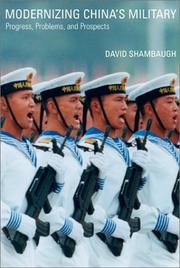
ISBN: 1282357913 9786612357916 0520938100 1597347604 9780520938106 0585466173 9780585466170 9781597347600 9780520225077 0520225074 0520225074 9781282357914 6612357916 0520242386 9780520242388 Year: 2002 Publisher: Berkeley University of California Press
Abstract | Keywords | Export | Availability | Bookmark
 Loading...
Loading...Choose an application
- Reference Manager
- EndNote
- RefWorks (Direct export to RefWorks)
David Shambaugh, a leading international authority on Chinese strategic and military affairs, offers the most comprehensive and insightful assessment to date of the Chinese military. The result of a decade's research, Modernizing China's Military comes at a crucial moment in history, one when international attention is increasingly focused on the rise of Chinese military power. Basing his analysis on an unprecedented use of Chinese military publications and interviews with People's Liberation Army (PLA) officers, Shambaugh addresses important questions about Chinese strategic intentions and military capabilities--questions that are of key concern for government policymakers as well as strategic analysts and a concerned public.
China - Armed Forces. --- China - Defenses. --- China-- Armed Forces. --- China --- Armed Forces. --- Defenses. --- HISTORY / Asia / General. --- asia scholars. --- asian studies. --- china. --- chinese government. --- chinese history. --- chinese military. --- foreign policy. --- international politics. --- interviews. --- military buffs. --- military capabilities. --- military forces. --- military history. --- military issues. --- military power. --- military prospects. --- military strategies. --- modern history. --- modernization. --- nonfiction. --- peoples liberation army. --- pla. --- policymakers. --- political science. --- political. --- social progress. --- strategic analysts.
Book
ISBN: 1283278502 9786613278500 0520950321 Year: 2011 Publisher: Berkeley, CA : University of California Press,
Abstract | Keywords | Export | Availability | Bookmark
 Loading...
Loading...Choose an application
- Reference Manager
- EndNote
- RefWorks (Direct export to RefWorks)
The essays in this groundbreaking book explore the meanings of manhood in Japan from the seventeenth to the twenty-first centuries. Recreating Japanese Men examines a broad range of attitudes regarding properly masculine pursuits and modes of behavior. It charts breakdowns in traditional and conventional societal roles and the resulting crises of masculinity. Contributors address key questions about Japanese manhood ranging from icons such as the samurai to marginal men including hermaphrodites, robots, techno-geeks, rock climbers, shop clerks, soldiers, shoguns, and more. In addition to bringing historical evidence to bear on definitions of masculinity, contributors provide fresh analyses on the ways contemporary modes and styles of masculinity have affected Japanese men's sense of gender as authentic and stable.
Men --- Masculinity --- Sex role --- Identity. --- anthropologists. --- anthropology. --- asia scholars. --- asian studies. --- behavioral studies. --- contemporary japan. --- cultural historians. --- early modern japan. --- essay collection. --- geeks. --- gender identity. --- gender roles. --- gender studies. --- generational. --- hermaphrodites. --- historians. --- historical. --- japan. --- japanese culture. --- japanese history. --- japanese men. --- japanese society. --- manhood. --- masculinity. --- mens issues. --- mens roles. --- nonfiction essays. --- samurai. --- shoguns. --- social science. --- sociologists. --- traditional roles.
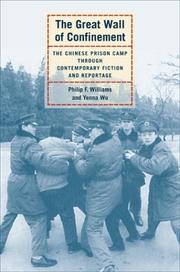
ISBN: 1282358065 9786612358067 0520938550 9780520938557 9781282358065 0520227794 9780520227798 6612358068 Year: 2004 Publisher: Berkeley University of California Press
Abstract | Keywords | Export | Availability | Bookmark
 Loading...
Loading...Choose an application
- Reference Manager
- EndNote
- RefWorks (Direct export to RefWorks)
China is the only major world power to have entered the twenty-first century with a thriving prison camp network-a frightening, mostly hidden realm known since 1951 as the laogai system. This book, the most comprehensive study of China's prison camps to date, draws from a wide range of primary sources, including many compelling literary documents, to illuminate life inside China's prison camps. Focusing mainly on the second half of the twentieth century, Philip F. Williams and Yenna Wu outline the evolution of the laogai system, construct a vivid picture of prisoners' lives from arrest and interrogation to release, and provide a troubling new perspective on the human rights issues plaguing China.
Internment camps --- Forced labor --- Political prisoners --- 20th century. --- anthropologists. --- asia scholars. --- china. --- chinese history. --- chinese law. --- chinese prison camp. --- chinese society. --- confinement. --- contemporary fiction. --- cultural anthropology. --- cultural historians. --- discussion books. --- historical. --- human rights issues. --- human rights. --- laogai system. --- law enforcement. --- literary documents. --- modern reports. --- nonfiction study. --- primary sources. --- prison camp network. --- prison life. --- prison stories. --- prisoners. --- social impact. --- world powers. --- China --- History --- Concentration camps
Book
ISBN: 0520948440 1283277646 9786613277640 9780520948440 9780520266599 0520266595 Year: 2011 Publisher: Berkeley, Calif. University of California Press
Abstract | Keywords | Export | Availability | Bookmark
 Loading...
Loading...Choose an application
- Reference Manager
- EndNote
- RefWorks (Direct export to RefWorks)
Intended as a reminder of Europe for soldiers and clerks of the empire, the city of Dalat, located in the hills of Southern Vietnam, was built by the French in an alpine locale that reminded them of home. This book uncovers the strange 100-year history of a colonial city that was conceived as a center of power and has now become a kitsch tourist destination famed for its colonial villas, flower beds, pristine lakes, and pastoral landscapes. Eric T. Jennings finds that from its very beginning, Dalat embodied the paradoxes of colonialism-it was a city of leisure built on the backs of thousands of coolies, a supposed paragon of hygiene that offered only questionable protection from disease, and a new venture into ethnic relations that ultimately backfired. Jennings' fascinating history opens a new window onto virtually all aspects of French Indochina, from architecture and urban planning to violence, labor, métissage, health and medicine, gender and ethic relations, schooling, religion, comportments, anxieties, and more.
Đà Lạt (Vietnam) --- France --- History. --- Colonial influence. --- Colonies --- asia scholars. --- asian history. --- asian studies. --- colonial historians. --- colonial villas. --- colonialism. --- cultural anthropology. --- cultural historians. --- cultural perspective. --- dalat. --- ethnic relations. --- ethnographers. --- ethnography. --- europe. --- french empire. --- french indochina. --- gender relations. --- health and medicine. --- historians. --- imperialism. --- nonfiction. --- political science. --- postcolonialism. --- regional history. --- southern vietnam. --- tourist destination. --- world history.
Book
ISBN: 9786612697692 1282697692 0520945808 9780520945807 9781282697690 9780520259188 0520259181 6612697695 Year: 2010 Publisher: Berkeley University of California Press
Abstract | Keywords | Export | Availability | Bookmark
 Loading...
Loading...Choose an application
- Reference Manager
- EndNote
- RefWorks (Direct export to RefWorks)
Kären Wigen probes regional cartography, choerography, and statecraft to redefine restoration (ishin) in modern Japanese history. As developed here, that term designates not the quick coup d'état of 1868 but a three-centuries-long project of rehabilitating an ancient map for modern purposes. Drawing on a wide range of geographical documents from Shinano (present-day Nagano Prefecture), Wigen argues that both the founder of the Tokugawa Shogunate (1600-1868) and the reformers of the Meiji era (1868-1912) recruited the classical map to serve the cause of administrative reform. Nor were they alone; provincial men of letters played an equally critical role in bringing imperial geography back to life in the countryside. To substantiate these claims, Wigen traces the continuing career of the classical court's most important unit of governance-the province-in central Honshu.
Cartography --- History. --- Nagano-ken (Japan) --- Japan --- Historical geography. --- Administrative and political divisions --- Maps --- administrative reform. --- asia scholars. --- asian studies. --- cartographers. --- cartography. --- classical maps. --- coup detat. --- early modern japan. --- geographical documents. --- government impact. --- historical geography. --- historical. --- honshu. --- imperial geography. --- ishin. --- japan. --- japanese countryside. --- japanese geography. --- japanese history. --- map rehabilitation. --- maps. --- meiji era. --- nagano prefecture. --- political history. --- regional cartography. --- restoration. --- shinano. --- tokugawa shogunate.
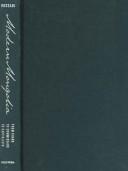
ISBN: 1597347590 1282358081 9786612358081 0520938623 1417585048 9780520938625 0520243994 9780520243996 0520244192 9780520244191 9781597347594 9781417585045 9781282358089 6612358084 Year: 2005 Publisher: Berkeley : University of California Press,
Abstract | Keywords | Export | Availability | Bookmark
 Loading...
Loading...Choose an application
- Reference Manager
- EndNote
- RefWorks (Direct export to RefWorks)
Land-locked between its giant neighbors, Russia and China, Mongolia was the first Asian country to adopt communism and the first to abandon it. When the Soviet Union collapsed in the early 1990's, Mongolia turned to international financial agencies-including the International Monetary Fund, the World Bank, and the Asian Development Bank-for help in compensating for the economic changes caused by disruptions in the communist world. Modern Mongolia is the best-informed and most thorough account to date of the political economy of Mongolia during the past decade. In it, Morris Rossabi explores the effects of the withdrawal of Soviet assistance, the role of international financial agencies in supporting a pure market economy, and the ways that new policies have led to greater political freedom but also to unemployment, poverty, increasingly inequitable distribution of income, and deterioration in the education, health, and well-being of Mongolian society. Rossabi demonstrates that the agencies providing grants and loans insisted on Mongolia's adherence to a set of policies that did not generally take into account the country's unique heritage and society. Though the sale of state assets, minimalist government, liberalization of trade and prices, a balanced budget, and austerity were supposed to yield marked economic growth, Mongolia-the world's fifth-largest per capita recipient of foreign aid-did not recover as expected. As he details this painful transition from a collective to a capitalist economy, Rossabi also analyzes the cultural effects of the sudden opening of Mongolia to democracy. He looks at the broader implications of Mongolia's international situation and considers its future, particularly in relation to China.
HistoryzMongolia. --- Mongolia - History - 1990-. --- Regions & Countries - Asia & the Middle East --- History & Archaeology --- East Asia --- Mongolia --- History --- History. --- HISTORY / Asia / General. --- Mongolie --- Economic conditions --- Histoire --- Conditions économiques --- asia scholars. --- asian studies. --- business and industry. --- capitalism. --- capitalist society. --- china. --- civic. --- commissars. --- communism. --- economic growth. --- economic history. --- foreign aid. --- history. --- international financial agencies. --- international relations. --- khans. --- minimalist government. --- modern history. --- money. --- mongolia. --- mongolian history. --- mongolian society. --- political history. --- political science. --- poverty. --- pure market economy. --- retrospective. --- russia. --- soviet union.
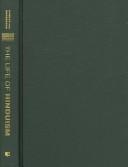
ISBN: 0520249135 9780520249134 9780520249141 0520249143 1282358634 9786612358630 0520940075 9780520940079 1433700042 9781433700040 9781282358638 6612358637 Year: 2006 Publisher: Berkeley University of California Press
Abstract | Keywords | Export | Availability | Bookmark
 Loading...
Loading...Choose an application
- Reference Manager
- EndNote
- RefWorks (Direct export to RefWorks)
The Life of Hinduism brings together a series of essays-many recognized as classics in the field-that present Hinduism as a vibrant, truly "lived" religion. Celebrating the diversity for which Hinduism is known, this volume begins its journey in the "new India" of Bangalore, India's Silicon Valley, where global connections and local traditions rub shoulders daily. Readers are then offered a glimpse into the multifaceted world of Hindu worship, life-cycle rites, festivals, performances, gurus, and castes. The book's final sections deal with the Hinduism that is emerging in diasporic North America and with issues of identity that face Hindus in India and around the world: militancy versus tolerance and the struggle between owning one's own religion and sharing it with others. Contributors: Andrew Abbott, Michael Burawoy, Patricia Hill Collins, Barbara Ehrenreich, Evelyn Nakano Glenn, Sharon Hays, Douglas Massey, Joya Misra, Orlando Patterson, Frances Fox Piven, Lynn Smith-Lovin, Judith Stacey, Arthur Stinchcombe, Alain Touraine, Immanuel Wallerstein, William Julius Wilson, Robert Zussman
Hinduism - Customs and practices. --- Hinduism - Social aspects. --- Religious life - Hinduism. --- Religious life --- Hinduism --- Religion --- Philosophy & Religion --- Customs and practices --- Social aspects --- Customs and practices. --- Social aspects. --- Hinduism. --- Religious life (Hinduism) --- Religions --- Brahmanism --- asia scholars. --- bangalore. --- caste system. --- comparative religion. --- diasporic communities. --- diversity. --- essay collection. --- global religions. --- globalism. --- gurus. --- hindu festivals. --- hindu worship. --- hinduism. --- hindus. --- india. --- indian history. --- indian society. --- life cycles. --- local traditions. --- nonfiction essays. --- religion and culture. --- religious historians. --- religious history. --- religious rites. --- religious scholars. --- religious studies. --- religious traditions. --- theology.
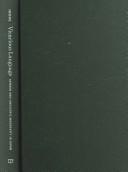
ISBN: 1282771965 9786612771965 0520939069 9780520939066 0520245849 9780520245846 0520245857 9780520245853 9781282771963 6612771968 Year: 2006 Publisher: Berkeley, Calif. University of California Press
Abstract | Keywords | Export | Availability | Bookmark
 Loading...
Loading...Choose an application
- Reference Manager
- EndNote
- RefWorks (Direct export to RefWorks)
This highly original study provides an entirely new critical perspective on the central importance of ideas about language in the reproduction of gender, class, and race divisions in modern Japan. Focusing on a phenomenon commonly called "women's language," in modern Japanese society, Miyako Inoue considers the history and social effects of this language form. Drawing on ethnographic fieldwork in a contemporary Tokyo corporation to study the everyday linguistic experience of white-collar females office workers and on historical research from the late nineteenth century to 1930, she calls into question the claim that "women's language" is a Japanese cultural tradition of ancient origin and offers a critical geneaology showing the extent to which this language form is, in fact, a cultural construct linked with Japan's national and capitalist modernity. Her theoretically sophisticated, empirically grounded, interdisciplinary work brilliantly illuminates the relationship between culture and language, the nature of power and subject formation in modernity, and how the complex nexus of gender, language, and political economy are experienced in everyday life.
Japanese language --- Women --- Koguryo language --- Human females --- Wimmin --- Woman --- Womon --- Womyn --- Females --- Human beings --- Femininity --- Sex differences. --- Language. --- Femmes --- Japonais (Langue) --- Langue --- Différences entre sexes --- Sociolinguistics --- Language --- asia scholars. --- asian studies. --- class differences. --- critical analysis. --- cultural traditions. --- ethnographers. --- ethnography. --- fieldwork. --- gender and language. --- gender studies. --- gendered language. --- genealogy. --- japan. --- japanese culture. --- japanese society. --- language and culture. --- linguistic modernity. --- modern japan. --- modernization. --- national identity. --- nonfiction study. --- office workers. --- political economy. --- racial issues. --- social effects. --- theoretical. --- tokyo. --- white collar workers.
Book
ISBN: 1283278146 0520949498 9786613278142 9780520949492 0520267834 9780520267831 0520267842 9780520267848 9781283278140 Year: 2011 Publisher: Berkeley : University of California Press,
Abstract | Keywords | Export | Availability | Bookmark
 Loading...
Loading...Choose an application
- Reference Manager
- EndNote
- RefWorks (Direct export to RefWorks)
Offering a concise, entertaining snapshot of Japanese society, Manners and Mischief examines etiquette guides, advice literature, and other such instruction for behavior from the early modern period to the present day and discovers how manners do in fact make the nation. Eleven accessibly written essays consider a spectrum of cases, from the geisha party to gay bar cool, executive grooming, and good manners for subway travel. Together, they show that etiquette is much more than fussy rules for behavior. In fact the idiom of manners, packaged in conduct literature, reveals much about gender and class difference, notions of national identity, the dynamics of subversion and conformity, and more. This richly detailed work reveals how manners give meaning to everyday life and extraordinary occasions, and how they can illuminate larger social and cultural transformations.
Power (Social sciences) --- Sex role --- Etiquette --- Empowerment (Social sciences) --- Political power --- Exchange theory (Sociology) --- Political science --- Social sciences --- Sociology --- Consensus (Social sciences) --- Japan --- Social life and customs. --- advice literature. --- asia scholars. --- behavior guides. --- class differences. --- conformity. --- cultural transformations. --- culture studies. --- early modern period. --- etiquette guides. --- everyday life. --- gay bars. --- geisha party. --- gender differences. --- gender norms. --- gender studies. --- japan. --- japanese culture. --- japanese society. --- modern japan. --- national identity. --- nonfiction. --- power dynamics. --- self help guides. --- social analysis. --- social etiquette. --- social history. --- subversion. --- subway travel.
Book
ISBN: 1282732579 9786612732577 0520947681 9780520947689 9780520266735 0520266730 9780520266742 0520266749 9781282732575 6612732571 Year: 2010 Publisher: Berkeley University of California Press
Abstract | Keywords | Export | Availability | Bookmark
 Loading...
Loading...Choose an application
- Reference Manager
- EndNote
- RefWorks (Direct export to RefWorks)
This remarkable book examines the complex history of Japanese colonial and postcolonial interactions with Korea, particularly in matters of cultural policy. E. Taylor Atkins focuses on past and present Japanese fascination with Korean culture as he reassesses colonial anthropology, heritage curation, cultural policy, and Korean performance art in Japanese mass media culture. Atkins challenges the prevailing view that imperial Japan demonstrated contempt for Koreans through suppression of Korean culture. In his analysis, the Japanese preoccupation with Koreana provided the empire with a poignant vision of its own past, now lost--including communal living and social solidarity--which then allowed Japanese to grieve for their former selves. At the same time, the specific objects of Japan's gaze--folk theater, dances, shamanism, music, and material heritage--became emblems of national identity in postcolonial Korea.
Postcolonialism --- Imperialism --- Public opinion --- Social aspects --- History --- Japan --- Korea --- Cultural policy. --- Colonial influence. --- Foreign public opinion, Japanese. --- Relations --- 20th century. --- asia scholars. --- asian studies. --- colonial anthropology. --- colonial gaze. --- colonialism. --- communal living. --- cultural analysis. --- cultural policy. --- cultural suppression. --- folk theater. --- heritage curation. --- japanese colonialism. --- japanese history. --- korea. --- korean culture. --- korean music. --- koreana. --- mass media culture. --- material heritage. --- modern history. --- national identity. --- performance art. --- political history. --- postcolonial korea. --- postcolonialism. --- shamanism. --- social history.
| Listing 1 - 10 of 23 | << page >> |
Sort by
|

 Search
Search Feedback
Feedback About UniCat
About UniCat  Help
Help News
News